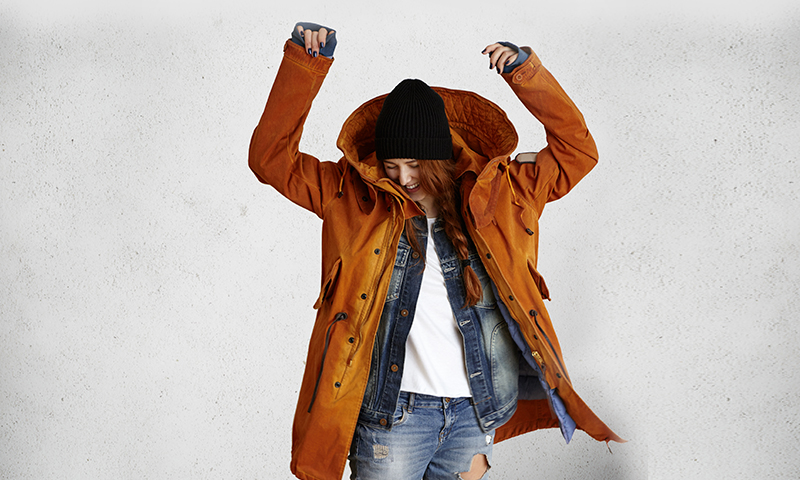Layer Up

Once the dust settled from the winter Fashion Week events in Milan, Paris, New York and London, one thing was clear: outerwear is having a moment. With runway models strutting their stuff in up to nine layers at a time, it’s a good bet that everything from form-fitting shells to bulky, Antarctica-worthy coats will be popular this fall.
Fashionista magazine attributes the extreme layering trend to the current protectionist political climate. In reaction to global uncertainty and actions such as Brexit, designers rolled out looks designed to both literally and figuratively insulate wearers from forces outside their control. Taking it to the next level, all four Fashion Weeks included apparel lines with wearable security blankets.
In a recent article on the resurgence of denim, the Wall Street Journal reported that denim jackets are back in style, but with a roomier fit to accommodate layers. Katy Mendoza, creative director for supplier Threadfast Apparel (PPAI 622344), agrees. “The latest retail trends seek to provide the perfect layering piece for transitional seasons,” she says. “We have witnessed the comeback of denim, the evolution of varsity jackets and beautiful embellishments on biker and bomber jackets.”
Other outerwear trends to look for, according to Elle magazine, include plaid, track suit-style zip-ups, colored denim and retro prints. While layering is always practical in transitional months, anticipate unexpected interpretations of this look, such as a t-shirt or camisole over a hoodie, or a hoodie under a structured blazer. And watch for signs that Millennial pink—a pale, milky hue worn as a neutral— appears be giving way to the new “it” color: lavender.
Last, expect the athleisure avalanche to continue. “Functionality and comfort are key,” says Lauren Cocco, director of merchandising for supplier Vantage Apparel (PPAI 113235). “Look for do-it-all (or transitional) silhouettes with sport and street influences in textured and stretch fabrications.”
---
Case Study
Engineering A New Look
The alumni relations and events manager at the University of Wisconsin-Madison’s College of Engineering wanted to bring more consistency to the look of the college’s promotional items to better promote its brand.
Wauwatosa, Wisconsin-based distributor Magellan Promotions worked with the school to provide new ideas and recommend specific items at different price points to fit their event and donor recognition needs from large scale, black-tie events to freshmen convocation and box lunch events.
The final product line included 10 items, with lightweight fleece jackets consistently named as a hands-down favorite for staff.
Instead of choosing a men’s apparel option that women could also wear, the office opted to purchase styles designed for men and women. This allowed for better tailoring and fit, so the items not only looked better but were worn more often.
With the newly designed assortment of promotional items and staff apparel, the department has achieved better organization and visual consistency, which has strengthened its brand identity.
Source: Magellan Promotions
---
Try This On For Size
Over the past 100 years, human beings have grown taller and heavier, particularly in developed countries. According to a study published in The Lancet, over 29 percent of the world’s population was considered overweight or obese in 2013. And the Wall Street Journal reports that between 35 and 60 percent of American women today wear a size 14 or larger.
Making and marketing clothing for growing waistlines is a challenge for manufacturers, particularly since many overseas factories do not have the appropriate machinery to accommodate it. On the upside, 10 percent of retail apparel sales can be attributed to purchases for plus-size women; there’s also a growing demand for larger sizes for men and youth.
A recent article in the Wall Street Journal reports that entrepreneurs are capitalizing on this market by designing clothes specifically for larger consumers. This strategy differs from mega brands who historically have designed clothes for smaller frames and then enlarged the styles to offer a full range of sizes.
Some of the major players in the market are starting to catch on, though. Last year, Walmart purchased ModCloth, a women’s specialty retailer that built its brand on size diversity and inclusivity. H&M and Target have also begun to design lines specifically for plus-size women.
As figures change, another issue for manufacturers is how to appropriately size clothing. Vanity sizing, or the practice of appealing to buyers’ egos by labeling garments smaller than they actually are, has made shopping confusing for consumers, too.
In response to these dynamics, an extensive body-measurement study is taking place across the United States and Canada. According to HanesBrands’s Apparel Tip Sheet, the Size NorthAmerica study will scan a diverse group of participants through 2018. The last time such a study occurred was 2013.
HanesBrands is one of many organizations backing the Size NorthAmerica study. Mike Abbott, director of research and development for the supplier, says, “The data from this study will allow us to develop reliable, up-to-date and realistic size tables and offer more comfortable fits for our consumers.”
---
The Demand For Safe, Organic Products Is Creating A Wave Of Alternative Materials
A recent article in The New York Times discussed the exploration of fabrics made from organic or recycled material. Here are some of the newest innovations from fashion designers.
- Silk created from protein fiber spun by spiders
- Nylon made from plastic salvaged from ocean trash
- Imitation leather developed from fruit waste or yeast
- Suede-like material manufactured from mushroom fiber
- Artificial fur developed from stem cells
- Paper yarn
Always willing to push the envelope, iconic fashion house Chanel is experimenting with 3D printing for ready-to-wear clothing made from compressed powder.
---
Terry Ramsay is associate editor of PPB.

